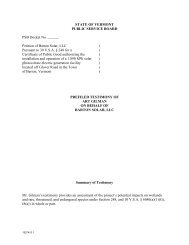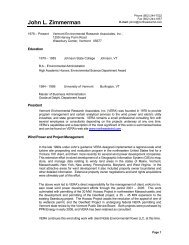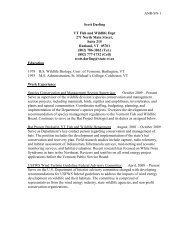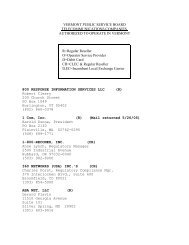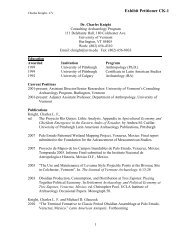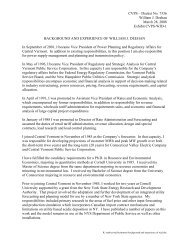Pre-Filed Testimony and Exhibits of David Raphael - Vermont Public ...
Pre-Filed Testimony and Exhibits of David Raphael - Vermont Public ...
Pre-Filed Testimony and Exhibits of David Raphael - Vermont Public ...
Create successful ePaper yourself
Turn your PDF publications into a flip-book with our unique Google optimized e-Paper software.
Aesthetic Assessment <strong>of</strong> the Proposed Beaver Wood Biomoss Facility<br />
2. The Quechee Analysis<br />
experiences is dependent upon the ...<br />
provision<br />
<strong>of</strong> aesthetically pleasing l<strong>and</strong>scapes<br />
<strong>and</strong> the degree to which the environment has been altered by human activity” (p. 94).<br />
It continues to identify some areas with scenic quality such as the Clarendon Gorge<br />
State Forest, as well as scenic roads including <strong>Vermont</strong> Route 30. However, the Plan<br />
does not identify the Project site as a scenic resource, nor does it contain specific<br />
provisions that would preclude development on the site due to its scenic quality.<br />
Moreover, there are no guidelines or st<strong>and</strong>ards specific to the aesthetics <strong>of</strong> energy<br />
generation other than to “Work with towns to find the most suitable locations for<br />
wind power production or other commercial scale power generation” (p. 132).<br />
This is an important consideration, since the Town <strong>of</strong> Fair Haven has loosely<br />
identified scenic views in its Town Plan, which do not include the Project site:<br />
Two major features dominate Fair Havens l<strong>and</strong>scape: the foothills <strong>of</strong> (lie Green<br />
Mountains <strong>and</strong> the Poultney River Valley. Much <strong>of</strong> Fair Havens rural character <strong>and</strong><br />
appeal results from the scenic vistas that can he observed in many parts <strong>of</strong> the town <strong>and</strong><br />
include an interplay <strong>of</strong> villages, nioun tains, forested hills, unbroken ridge lines, farms,<br />
fields, rivers, streams, ponds <strong>and</strong> wood l<strong>and</strong>s. Fair Haven is also fortunate to have many<br />
tree-lined streets in its village <strong>and</strong> along its outlying roads. Trees provide shade, beauty<br />
<strong>and</strong> habitat; can serve as food sources, <strong>and</strong> reduce air <strong>and</strong> noise pollution. They also can<br />
increase property values as much as 10%. Species in Fair Haven include the stately sugar<br />
maple (p. 41).<br />
Policies to protect scenic views include:<br />
Identify, protect <strong>and</strong> preseroe important natural <strong>and</strong> historic features <strong>of</strong> the <strong>Vermont</strong><br />
l<strong>and</strong>scape, including significant natural <strong>and</strong> fragile areas; outst<strong>and</strong>ing water resources,<br />
including lakes, rivers, aquifers, shorelines; wetl<strong>and</strong>; outst<strong>and</strong>ing l<strong>and</strong> resources<br />
including significant scenic roads, views; <strong>and</strong> the quality <strong>of</strong> air, <strong>and</strong> encourage <strong>and</strong><br />
strengthen agriculture <strong>and</strong> forest indus tries...” (p. 46)<br />
However, there are no other specifically identified scenic areas, nor are there any<br />
clearly defined criteria, st<strong>and</strong>ards, or guidelines to implement these broad goals, or<br />
that limit or strictly prohibit industrial development. Moreover, the Town Zoning<br />
has identified this area as an Industrial District, the purpose <strong>of</strong> which is “To al]ow for<br />
light <strong>and</strong> heavy industry such as slate or stone works, machine shops, textile<br />
manufacture, laundry <strong>and</strong> dry cleaning plants or similar operations as described in<br />
the Table <strong>of</strong> Uses. These areas are separated from residential <strong>and</strong> natural areas to<br />
minimize use conflicts” (p. 13).<br />
In conclusion, the applicable Regional <strong>and</strong> Town plans do not contain “clear, written<br />
community st<strong>and</strong>ards intended to preserve the aesthetics or scenic beauty <strong>of</strong> the<br />
‘11



